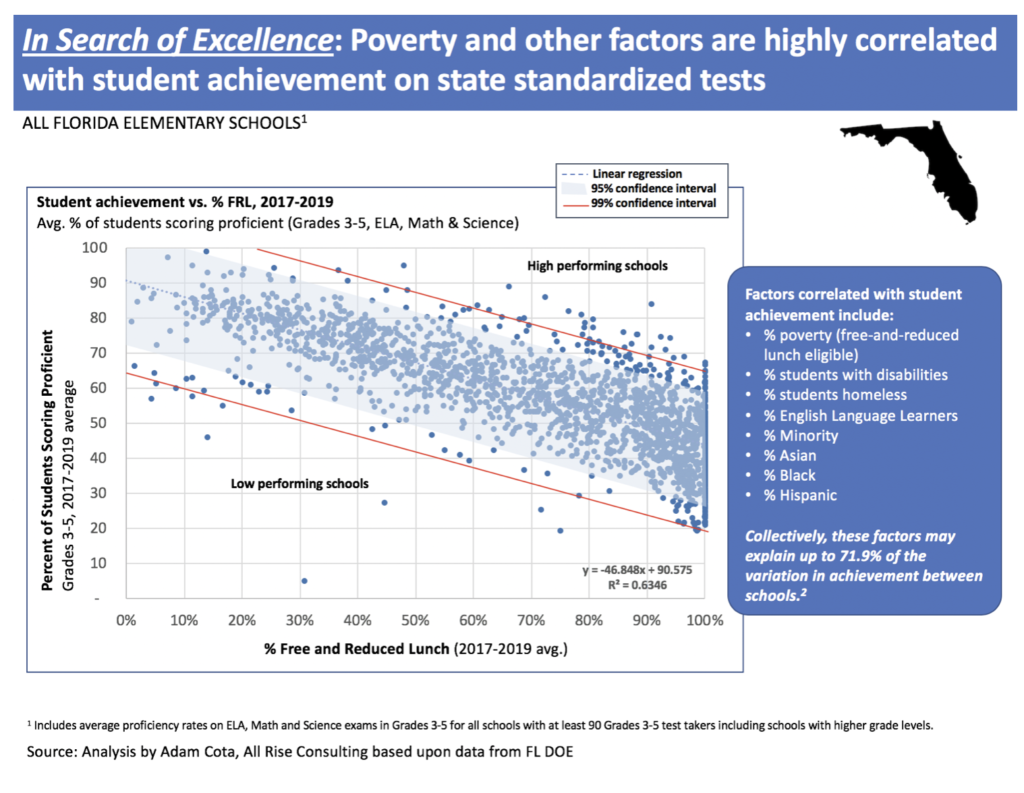DeSantis Embraces “Adjusting For Demographics”
When the Governor released his statement on Florida’s performance on the 2022 NAEP assessment, we expected (and we got) spin but there was one thing no one expected – the phase “when adjusted for demographics.”

Note that the Governor celebrates Florida’s “rankings” and not test scores. That is because, when you look at the actual test scores there isn’t much to celebrate, as highlighted in a Tampa Bay Times editorial entitled “Florida schools’ report card? Needs improvement – Grading against a pandemic curve doesn’t help students to learn.” They noted “The Nation’s Report Card is in, and the grades in America and Florida are poor. Blame whoever or whatever you want — the pandemic, distance learning, the way students are taught. But please don’t try to parse it and pretend to find only good news. There just isn’t much.”

The decline in scores was expected, of course. The Covid pandemic disrupted all our lives, not just our children’s schooling. Many of us suffered the loss of loved ones, but all of us suffered in one way or another. This year’s NAEP scores reflect the magnitude of that disruption.
This blog post, however, is not about COVID or NAEP scores, it is about Governor DeSantis’ willingness to “adjust” results for demographics. This is something Florida has resisted doing for the past 2 decades, ever since Jeb Bush suggested such adjustments were “the soft bigotry of low expectations.”
Florida’s Accountability Model is based on standardized test scores. There is a very strong correlation between standardized test scores and family income. Test scores are higher in areas with high family income and lower in areas with low family income, and schools with higher poverty rates have lower passing rates on state assessments.
In 2019, we drew attention to the work of Adam Cota, a Naples area education consultant, who took a closer look at Florida’s School Grades report. After analyzing 3 years of school grades, achievement data and indicators of at-risk students for Florida’s elementary level schools (only looking at test scores for grades 3-5), he was able to identify schools that were both outperforming and underperforming expected outcomes. He noticed that, when comparing predicted performance (after adjusting for demographics) with a school’s actual performance, 25-40% of A and B rated schools underperformed expectations. He also identified school districts who were “beating the odds” with elementary schools which outperformed expectations most of the time.

Cota’s recommendations included:
State officials should consider modifying or adding to the School Grade system which currently provides a misleading letter grades which too many misinterpret as an indication of school “quality.” For instance, in addition to current letter grades, the state could indicate whether the school ‘significantly outperforms’, ‘outperforms’, ‘underperforms’ or ‘significantly underperforms’ expectations after factoring in at-risk student populations that are significantly correlated to student achievement (poverty, disabilities, English Language Learners, homelessness, etc).
https://www.linkedin.com/pulse/floridas-school-grades-under-microscope-adam-cota
In other words, Cota thought Florida should admit that demographics matter.
Modifying the current system to adjust for demographics, Cota argued, would all us to move away from traditional talking points and social media spin and allow Florida to “focus on properly identifying – and replicating — truly great schools for all of our kids. They deserve it.”
Despite the significant impact of poverty, homelessness, foster care status and race on student performance, Florida’s Accountability Model has resisted making adjustments for demographics. For example:
School grades are not adjusted for demographics: The primary components of school grade calculations (the ONLY components for elementary schools) are state standardized test scores. When Standardized test scores are used to calculate school grades, school grades also correlate with family income. This explains why, although there have been A-rated high poverty schools, there has never been an “F” school in a wealthy/low poverty school. Cota’s analysis found 85% of wealthy/low-poverty schools received an “A” compared to only 10% of high-poverty schools.
Requirements for School Turnaround are not adjusted for demographics: As part of its School Improvement program, Florida, annually, identifies district-managed public schools which have received an “F” or two consecutive “D” grades as “turnaround schools” and their districts are required to implement a “turnaround plan,” which includes the additional activities/strategies they will implement to improve student outcomes and raise the school’s grade to a “C” or better. Turnaround schools that remain below a “C” after two years are required to close (and send the students to higher performing schools) or use a privatized option (hire an external operator or convert to a charter school). Currently ALL of the Florida public schools undergoing turnaround are Title I (low income) schools. (This is not surprising because Turnaround status is based on school grades, which correlates with income status). Under the system, these schools must must improve or close/privatize.
What if school grades were adjusted for demographics, as Cota recommended? Would Florida be able to identify and identify low-income schools which are actually outperforming for their demographic? Don’t parents deserve this information? Does the current system risk disrupting, or even closing, these outperforming low-income schools?
Currently, there seems to be a push towards Charter School conversion, though that failed completely in Jefferson County. Once the poster-child of the Schools of Hope scheme, after 5 years of increased financial support from the state, Academica’s Somerset Inc, the charter school corporation who took over both (all) of Jefferson County’s persistently failing schools, walked away without renewing their contract and the schools were returned to the local district school board.
Florida’s VAM formula does not adjust for demographics: Florida’s State Board of Education (FLBOE) insists on the use of VAM scores to rid low performing schools of their “ineffective” teachers. They demand that turnaround plans include keeping only those teachers rated as “effective” and “highly effective.” Of course, Florida’s VAM formula, by law (f.s.1012.34(7)a), is forbidden from considering “gender, race, ethnicity, or socioeconomic status” when evaluating teacher performance. I suspect that, if VAM scores adjusted for the demographics, analysis would reveal that, like school grades, some “ineffective” teacher were actually “significantly outperforming” for their students. Since teacher raises are dependent on evaluations based on such calculations, this may explain why it is so difficult to recruit and retain teachers in high poverty schools.
If Governor DeSantis, along with Commissioner of Education Manny Diaz Jr., are willing to celebrate NAEP scores “adjusted for demographics” (even if its simply to promote political talking points), we hope they will embrace the idea of doing the same for our Accountability system. We should be using a system that identifies and celebrates the teachers and schools who are outperforming for all of our students, whatever their struggles may be. I agree with Adam Cota. Florida’s Accountability System should focus on properly identifying – and replicating — truly great schools for all of our kids. This is information our parents want to know and our students deserve.
